Pre 1740
If only the silver could talk! Collecting early English silver is a marvellous way to gain insight into a fascinating period of history, a time of great political and social turmoil marked by civil war and regicide. As we handle the beautiful hand-crafted pieces we can reflect on the changing monarchs and the murderous plots, plagues and a fire that destroyed most of London. It’s quite remarkable that these unique pieces have survived for over 300 years and are still able to provide enjoyment and utility of purpose as they did when they were first made.
Pre-1740 silver represents a fascinating period in the history of silver-making, where handcrafted silver objects were considered some of the most luxurious and valuable items one could own. During this time, silver was crafted primarily by skilled artisans who used traditional methods and tools to create the intricate designs and shapes. The changing monarchs and political regimes in Europe had a significant impact on the design and style of silver objects during this period.
For example, during the reign of King Charles II in England (1660-1685), silver objects were often designed with ornate and decorative baroque-style patterns, which reflected the luxurious and ostentatious nature of the court. A marked change from the sober styles of the preceding decades of civil war and Puritan rule. The elaborate silver objects crafted during the Charles II period often had an exuberant embossed decoration in deep relief, usually of flowers and foliage, sometimes with animals.
In contrast, during the reign of King William III and Queen Mary II in England (1689-1702), silver objects began to reflect a more restrained and formal style, which was influenced by the Dutch design aesthetic. The simpler and more elegant designs of silver objects were often complimented by wide gadroon borders and fluted decoration. The turn of the 17th/18th century was impacted by the technical advances in silver making brought to England by the Huguenot refugees fleeing religious persecution in France.
The reign of Queen Anne in England (1702-1714) saw a marked rise in consumer demand for art and luxury goods. The latest fashion for dining “a la francaise” required a whole range of lovely new domestic silverware including silver items such as ladles, cruet stands, sauceboats and tureens. The arrival of the new drinking beverages (tea, coffee and chocolate) from the colonies required serving receptacles and silver teapots, coffee pots, cream jugs etc started to appear around this time.
The Georgian period (1714–1830) saw the creation of great wealth and stability resulting from the expansion of the British Empire and Industrialisation. During the reigns of George I and George II the quality and range of silverwares continued to expand and there was a shift towards a more refined and elegant style. The 1730’s heralded the arrival of rococo silver with its exuberant decoration of curves, undulations and asymmetrical shapes modelled on nature. The years 1760-1830 were dominated by the Neoclassical style characterized by clean lines, geometric shapes, and delicate floral motifs inspired by classical antiquity.
Some of the finest examples of pre-1740 silver can be found at Waxantiques, including rare 16th century Elizabethan period silver goblets, magnificent silver ewers which were often used as decorative pieces in wealthy households during the 17th century, and early silver tea and coffee wares such as the Queen Anne silver chocolate pots and Georgian silver teapots introduced during the first quarter of the 18th century. These objects continue to be highly valued for their beauty, craftsmanship, and historical significance.
Pre 1740
If only the silver could talk! Collecting early English silver is a marvellous way to gain insight into a fascinating period of history, a time of great political and social turmoil marked by civil war and regicide. As we handle the beautiful hand-crafted pieces we can reflect on the changing monarchs and the murderous plots, plagues and a fire that destroyed most of London. It’s quite remarkable that these unique pieces have survived for over 300 years and are still able to provide enjoyment and utility of purpose as they did when they were first made.
Pre-1740 silver represents a fascinating period in the history of silver-making, where handcrafted silver objects were considered some of the most luxurious and valuable items one could own. During this time, silver was crafted primarily by skilled artisans who used traditional methods and tools to create the intricate designs and shapes. The changing monarchs and political regimes in Europe had a significant impact on the design and style of silver objects during this period.
For example, during the reign of King Charles II in England (1660-1685), silver objects were often designed with ornate and decorative baroque-style patterns, which reflected the luxurious and ostentatious nature of the court. A marked change from the sober styles of the preceding decades of civil war and Puritan rule. The elaborate silver objects crafted during the Charles II period often had an exuberant embossed decoration in deep relief, usually of flowers and foliage, sometimes with animals.
In contrast, during the reign of King William III and Queen Mary II in England (1689-1702), silver objects began to reflect a more restrained and formal style, which was influenced by the Dutch design aesthetic. The simpler and more elegant designs of silver objects were often complimented by wide gadroon borders and fluted decoration. The turn of the 17th/18th century was impacted by the technical advances in silver making brought to England by the Huguenot refugees fleeing religious persecution in France.
The reign of Queen Anne in England (1702-1714) saw a marked rise in consumer demand for art and luxury goods. The latest fashion for dining “a la francaise” required a whole range of lovely new domestic silverware including silver items such as ladles, cruet stands, sauceboats and tureens. The arrival of the new drinking beverages (tea, coffee and chocolate) from the colonies required serving receptacles and silver teapots, coffee pots, cream jugs etc started to appear around this time.
The Georgian period (1714–1830) saw the creation of great wealth and stability resulting from the expansion of the British Empire and Industrialisation. During the reigns of George I and George II the quality and range of silverwares continued to expand and there was a shift towards a more refined and elegant style. The 1730’s heralded the arrival of rococo silver with its exuberant decoration of curves, undulations and asymmetrical shapes modelled on nature. The years 1760-1830 were dominated by the Neoclassical style characterized by clean lines, geometric shapes, and delicate floral motifs inspired by classical antiquity.
Some of the finest examples of pre-1740 silver can be found at Waxantiques, including rare 16th century Elizabethan period silver goblets, magnificent silver ewers which were often used as decorative pieces in wealthy households during the 17th century, and early silver tea and coffee wares such as the Queen Anne silver chocolate pots and Georgian silver teapots introduced during the first quarter of the 18th century. These objects continue to be highly valued for their beauty, craftsmanship, and historical significance.
-

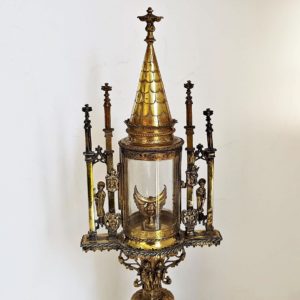
Circa 1524
9787 Antique Italian Gilt and Silver Monstrance
£12,500
A rare medieval copper gilt and silver monstrance with a steeple top. The central section has a glass hinged door flanked either side by two niches containing the figures of Saint Peter and Saint Paul; the pillar tops are detachable. The knopped stem is mounted with 4 saint figures. The hexafoil foot, beautifully engraved and chased, is mounted with 3 silver discs engraved with Jesus Christ, the Virgin Mary and Saint Sebastian. The underside bears an engraved inscription in old Italian, dated 1524, for the Italian church of San Piero di Porto di Legnago, near Verona. Height 38.5cm. Width 14.8cm. Italian. Date circa 1524. There are no silver marks which is normal for a religious article of such an early date.
-

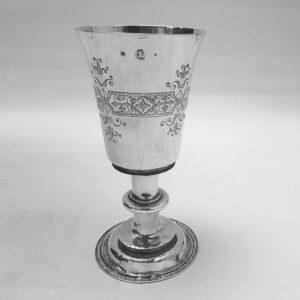
Circa 1574
Lawrence Stratford
10321 Elizabeth I Antique Silver Chalice
Sold
Originating from the English provincial town of Dorchester in Dorset, this fine early English chalice dates to the reign of Elizabeth I. It has the standard design for Elizabethan communion cups with straight tapering sides and a slightly flared top; with wire ornament applied to the stem and hammered egg and dart frieze to the foot. The beautifully hatched decorative bands below the top edge of the cup are typical for the period, they are well executed and with good definition. Most likely this cup has been made from pre-reformation silver and it has the lovely hand beaten finish you’d expect at this date. The removable cover (paten) bears the date of 1574. Superb antique colour.
Contains 250 ml. Chalice weight 231 grams, 7.4 troy oz. Height 20.2cm, diameter of top 9.9cm. Cover weight 55 grams, 1.7 troy oz. Height 2.4cm, diameter 9cm. London c.1574.
Maker’s mark only for Lawrence Stratford. Sterling silver. 16th century. -

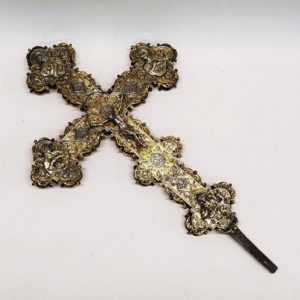
Circa 1600
9461 Antique Continental Silver Processional Cross
£12,500
A rare early silver processional cross. The embossed silver has applied plaques to the front and reverse and a “corpus” (figural image of Christ’s body). Bright parcel gilt finish. Bronze terminals enhance the ornate form of the cross. Height 48.5cm including the metal rod support, 40.5cm without. Width 29cm. Unmarked. Probably Italian circa 1600.
-

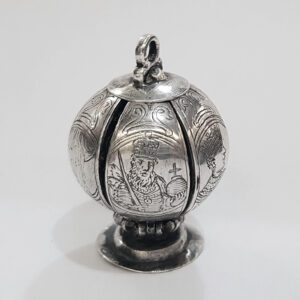
Circa 1600 - 1620
10349 17th Century Antique Silver Pomander
Sold
An intriguing piece of history contained in a small silver sphere. The antique silver pomander was worn round the neck or suspended from a belt and was intended to protect the wearer from sickness. The exterior of this example is hand engraved with royal portraits, probably English, based on engravings by Simon de Passe (c. 1595 – 6 May 1647). The screw top unturns to release six hollow, hinged segments to contain dried flowers, spices and scented oils. The interior is decorated with scroll and hatched engraving. A similar example formed part of the prestigious David Little collection. Weight 22 grams, less than 1 troy ounce. Height 3.9cm. Spread 5.6cm fully extended. Unmarked silver. Probably English. Circa 1600-20.
-

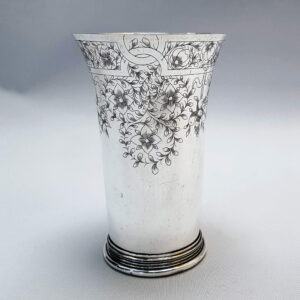
1618
10380 Dutch Antique Silver Beaker
£7,750
A rare example of early Dutch provincial silver. A beautiful antique silver beaker of tall tapering form with a flared rim. Good size and excellent gauge silver. The cup is hand engraved with a strapwork border and fine quality foliate scroll decoration interspersed with flower heads and fruit clusters. The base is scratch engraved with owner’s initials and possibly a date “A.1628”. Contains 600 ml. Weight 255g, 8.2 troy oz. Height 15cm. Diameter 10.2cm (top). Breda, Netherlands. Date1618.
-

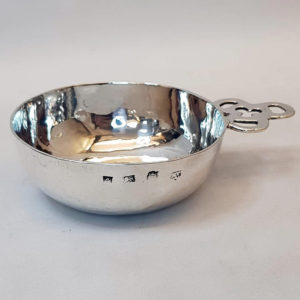
1625
Robert Profit
9989 Charles I Antique Silver Bowl
Sold
An extremely early date. A rare antique silver porringer (or bleeding bowl) of plain circular form. The straight sided shape with a simple rim is the earliest type and in keeping with the early date. Small proportions and very charming with the original hand beaten finish. A useful serving bowl, handy for nuts and sweets. Prick marked on the edge of the rim with the initials “MC”. Weight 108 grams, 3.4 troy ounces. Diameter 10.3cm. Height 3.5 cm. Spread 14cm. London 1625. Maker “RP” possibly Robert Profit (David Mitchell’s “Silversmiths in Elizabethan and Stuart London”).
-

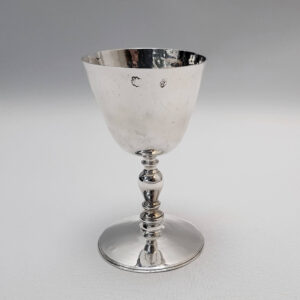
Circa 1630
Daniel Gee
10359 Charles I Antique Silver Wine Cup
£7,950
An exquisite little antique silver cup dating from the early 1600’s. It’s very rare to find a small cup from this date and with such fine proportions. The tapering bowl stands on a knopped stem with a spreading circular foot. Contains 85ml. Weight 115g, 3.6 troy oz. Height 11.7cm. London circa 1630. Maker Daniel Gee. Sterling silver.
-

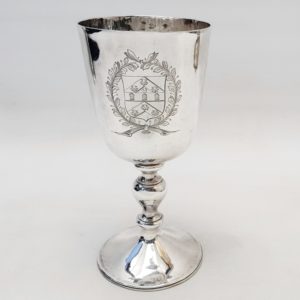
1631
10256 Charles I Antique Silver Cup
Sold
A superb early English silver wine cup of very plain form with a cast baluster stem and spreading foot. This large goblet has an excellent patina, good weight, and sits very well in the hand. To the front is a well-executed armorial for Dr Thomas Eden, hand engraved, the style is typical of the Charles I period with the shield within a laurel-wreath. This is an outstanding piece of antique silver in every way. Contains 430 ml. Weight 326 grams, 10.4 troy ounces. Height 19.8cm. Diameter 9.2cm (top), 9cm (foot). London 1631. Maker “HM”. Sterling silver. 17th century.
-

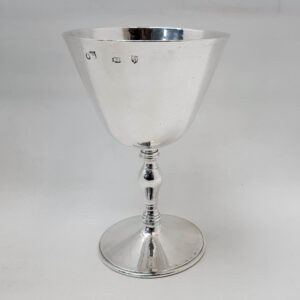
1635
Henry Starkey
10306 Charles I Antique Silver Wine Cup
£18,500
A rare English silver wine cup of very plain form on a cast baluster stem and spreading foot. This goblet has a superb patina and is perfectly styled for use in modern day times with its unusual tapering bowl. The original slightly hand beaten finish is visible on the inside. Contains 300 ml. Weight 207 grams, 6.6 troy ounces. Height 15.8cm. Diameter 10.7cm (top), 8.1cm (foot). London 1635. Maker probably Henry Starkey. Sterling silver. 17th century.
-

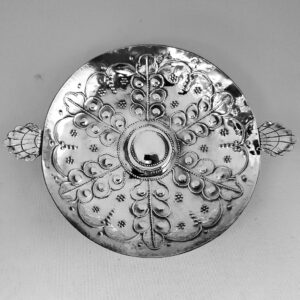
1640
10405 Charles I Antique Silver Sweetmeat Dish
£5,500
A very beautiful 17th century silver dish with leaf side handles, dating back to the first half of the 1600’s. Of circular form, hand decorated with a segmented foliate design and a central cartouche with concentric punches. This form is sometimes described as a wine taster however this example doesn’t have the domed centre for viewing the colour of the wine. Excellent patina. Weight 124g, 3.9 troy oz. Spread 21cm. Diameter 15cm. Height 2.3cm. London 1640. Maker “IM”. Sterling silver.
-

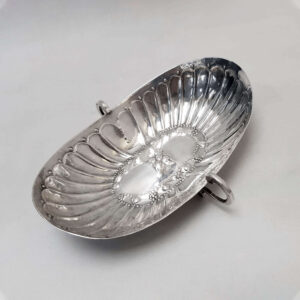
1641
10277 Charles I Antique Silver Wine Taster
£4,950
An early English silver taster of a rare boat shaped form with simple shaped side handles. The decoration is typical for the period, the body having a fluted design with punched dots and a flower head to the centre. Dishes from this period are occasionally referred to as sweetmeat dishes. Weight 88 grams, 2.8 troy ounces. Length 15.2cm. Width 9.6/12.5cm. Height 2.2/3.9cm. London 1641. No maker’s mark. Sterling silver. 17th century.
-

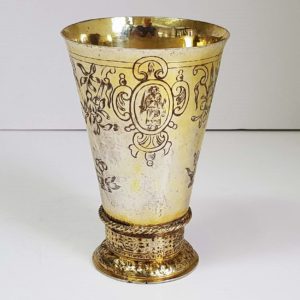
Circa 1650
9680 Antique Dutch Silver Beaker
£4,650
An antique silver beaker of tapering cylindrical form on a cast, coin inset, foot. Bright gilding inside and out. The body is decorated with 3 figures within oval cartouches surrounded by engraved floral and fruit designs. Contains 270 ml. Weight 230 grams, 7.3 troy ounces. Height 13.5cm. Dutch silver marks, possibly Groningen. Maker’s mark 3 anchors. Circa 1650.
-

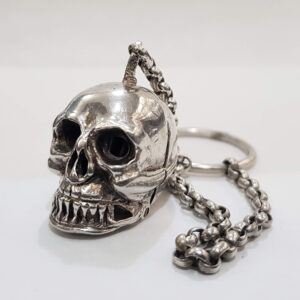
Circa 1650
10381 17th Century Silver Skull Pomander
Sold
A fascinating piece of early silver steeped in history and symbolism. Modelled in the form of a skull, this early German silver pomander has a segmented interior to contain fragrant spices. Originally a talisman to ward off sickness and noxious odours, this exquisite item of jewellery could be worn round the neck or suspended from a belt. The skull opens into 2 hinged compartments, one side divided into 6 segments beneath a gilded cover engraved with spice names – Citron, Rosmarin, Rosen, Citron, Schlag, Canel, Negeln, the other side to contain a sponge soaked in the perfumed oils/spices. The screw post, on a later chain, holds the piece tightly together. Weight 31g, 1 troy oz. Height 3/2.2cm. Spread 4cm open, 3.1cm closed. Probably German. Circa 1600-20. Unmarked silver.
-

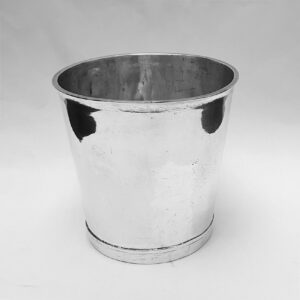
1654
John Winterton
10340 Commonwealth Period Antique Silver Beaker
£2,850
An early English silver drinking cup of small size. Plain tapering design with a turned over lip and simple foot. Contains 240 ml. Weight 63 grams, 2 troy ounces. Height 7cm. Diameter 7.5cm. London 1654. Maker John Winterton. Sterling silver.
-

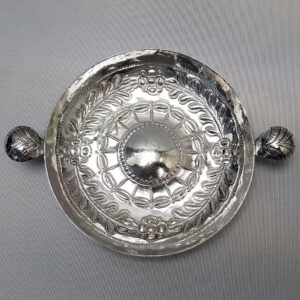
1656
William Harrison
10395 Commonwealth Period Antique Silver Wine Taster
Sold
A rare and very beautiful 17th century silver dish with leaf side handles and hand decorated with bands of flowers, leaves and prick dot engraving. Although rather shallow, this is probably a wine taster as it has the domed centre for viewing the colour of the wine. This could also be called a sweetmeat dish. The centre is engraved with prick dots and initials “S over W*M”. Excellent patina. Weight 128g, 4.1 troy oz. Spread across handles 20.3cm, 8 ins. London 1656. Maker William Harrison. Sterling silver
-

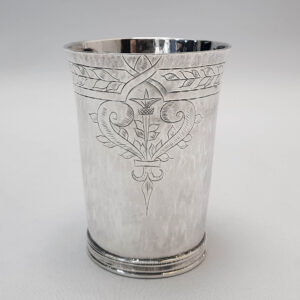
1657
Edward Treen
10416 Commonwealth Antique Silver Beaker
£10,750
A superb antique silver cup dating back to the turbulent mid 1600’s. Of tapering cylindrical form it has a flared rim and simple foot wires. Hand engraved to the top with a band of strapwork interspersed with foliate and scroll motifs. The front is stipple engraved with initials ‘MT’. Fine patina and hand beaten finish. Contains 350ml. Weight 177g, 5.6 troy oz. Height 10.6cm. Diameter of top 8.3cm. London 1657. Maker Edward Treen. Sterling silver.
-

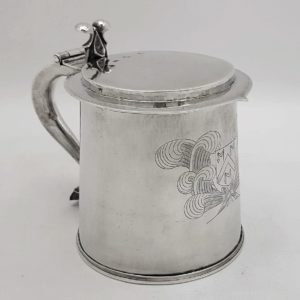
1659
Anthony Ficketts
9875 Commonwealth Silver Tankard
£15,950
A rare early English silver flat top lidded tankard with a cast, kidney shaped thumbpiece. The S-scroll handle has a shield terminal. Circa 1640 is the earliest date at which this tankard shape occurs and it’s unusual to find a tankard from this turbulent period and early date. Very charming, with hand beaten silver, the tankard displays a lot of character; a nice feature is the pointed front of the lid. Hand engraved to the front with a flat topped shield within ostrich plume feathers, a popular style of engraving from 1660-1690. Contains 1300 ml. Weight 763 grams, 24.5 troy ounces. Height 16.3cm (to top of thumb piece). Spread 15.7 cm. Diameter 11.4cm (inside top), 13.3 cm (base). London 1659. Silver from this period is very rare. Maker Anthony Ficketts, attribution by David Mitchell “Silversmiths in Elizabethan and Stuart London”. Sterling silver.
-

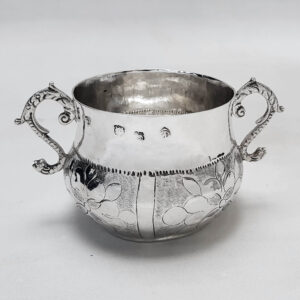
1662
Edward Treen
10339 Charles II Antique Silver Porringer
£2,950
A very early English twin handled silver cup with cast serpent form side handles. This little porringer (or caudle cup) combines some of the austere decoration associated with the Commonwealth period with the addition of hand engraved flowers marking the transition into the joyful Restoration period of Charles II. Superb colour. An attractive feature is the decorative base, very reminiscent of sweetmeat dishes of this period. Contains 250ml. Weight 113 grams, 3.6 troy ounces. Diameter 7.7 cm. Height 7cm (to top of handle). London 1662. Maker Edward Treen, specialist cup, porringer and sweetmeat dish maker. Sterling silver.
-

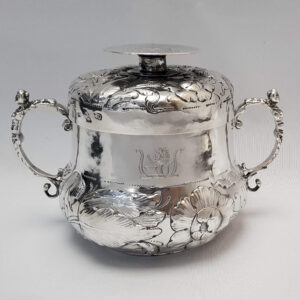
1666
Gowen Udall
10368 Charles II Antique Silver Porringer
Sold
A magnificent piece of early English silver. A large 2 handled antique silver cup and cover with caryatid handles; the body decorated all round with deep relief flowers and foliage typical of this early date. The hand beaten finish is very appealing. The matching cover has a capstan shaped finial so that the lid can be turned upside down and used on its own as a saucer. The lid finial bears a large hand engraved armorial with a crest and motto; the crest is repeated to the front and reverse of the porringer body. The underside has a large presentation inscription dated 1666. Weight 603g, 19.3 troy oz. Spread across handles 20cm. Height 14.5cm (total), 11.2cm (top of handle), 10.5cm (top of body). Diameter 11.8cm. London 1666. Maker probably Gowen Udall – source David Mitchell’s “Silversmiths in Elizabethan and Stuart London”. Sterling silver.
-

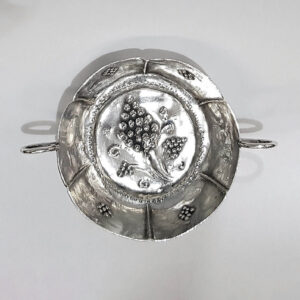
Circa 1670
10393 Charles II Antique Silver Miniature Wine Taster
£1,250
A charming little early English miniature dish from the reign of Charles II. Very sweet size. This little cup has a circular form with simple wirework handles and an embossed grape decoration. Owner’s initials “AA” engraved to the top rim. Weight 12 grams, less than half a troy ounce. Height 1.5 cm approx. Diameter of top 5.2cm. Spread across handles 7.4cm. English, circa 1670. Unmarked sterling silver.
-

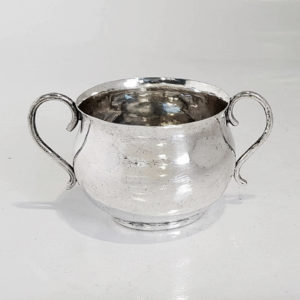
1673
8394 Charles II Antique Silver Brandy Cup
£1,750
A rare early English silver tot cup, or small size porringer, with twin side handles and belly shape. Lovely original hand beaten finish. Lovely original hand beaten finish. Weight 69 grams, 2.2 troy ounces. Height 5.5 cms. Diameter 6 cms. London 1673. Maker IC* listed in Jacksons.
-

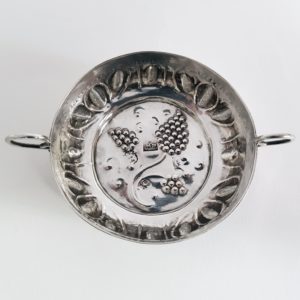
1673
George Watkins
10182 Charles II Antique Silver Wine Taster
£2,750
A rare early English miniature wine taster from the reign of Charles II. Very charming size. This little cup has a circular form with simple wirework handles and embossed grape decoration. Weight 21 grams, less than 1 troy ounce. Height 2 cm approx. Diameter of top 6.1cm. Spread across handles 8.9cm. London 1673. Made by George Watkins. Sterling silver.
-

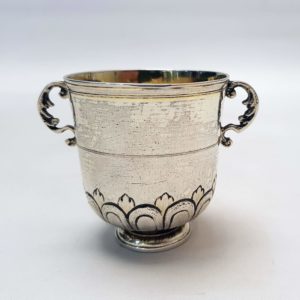
Circa 1674
10260 Antique Augsburg Silver Drinking Tot
£1,650
A delightful little antique silver cup with a faded gilt patina; having cast foliate side handles and decorative motifs to the lower body. Original bright gilt interior. Contains 70ml. Weight 70 grams, 2.2 troy ounces. Height 6cm. Diameter 5.5cm. Made in Augsburg, Germany. Circa 1674. 17th century.
-

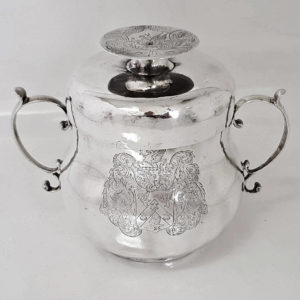
1675
Simon Romney
8739 Antique Charles II Silver Porringer
Sold
A rare piece of early English silver. A large 2 handled antique silver porringer of plain form. The matching cover has a capstan shaped finial so that the lid can be turned upside down and used on its own as a saucer. This has the form of a typical early Restoration porringer, with bellied shape and the lid sitting over the upper rim. There is a small silver support either side next to the handle for the lid to sit on. Hand engraved to the front, and repeated on the cover, are the arms and crest for the Yong family of Medhurst, Sussex. Weight 375 grams, 12 troy ounces. Height 14 cm (total), 10 cm (cup), 4.5 cm (lid). Diameter 10 cm. Spread across the handles 17 cm. London 1675. Makers mark “SR”* in a shield (there are 2 similar marks in Jacksons, see page 124 and 129, bottom of the page), probably Simon Romney.
-

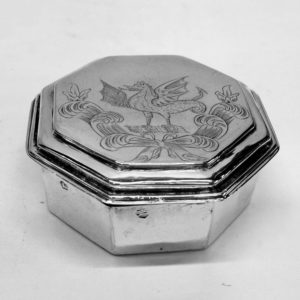
1675
Isaac Dighton
9172 Antique Charles II Silver Boxes
£6,950
A very rare matching pair of early antique silver boxes of octagonal form, with pull off tops, dating from the reign of King Charles II. Sterling silver. Simple plain form with a large hand engraved crest within tied plumage, very typical of the date. Superb antique colour. At this date boxes of this type would have originally been part of an extensive toilet service. Total weight 239 grams, 7.6 troy ounces. Height 3.5 cm. Width of top 9 cm. London 1675. Maker Isaac Dighton, London.
-

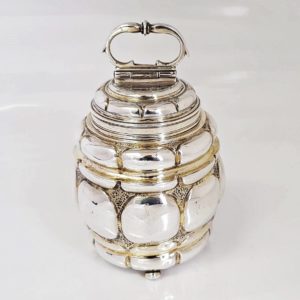
1675 - 1679
Marx Schaller
9789 Antique German Silver Tea Cannister
£6,500
A 17th century German parcel-gilt silver caddy of barrel shape. With a screw top lid and drop ring handle. Beautifully made and very tactile to hold. Suitable for tea and sugar. Raised on four ball feet, the box is decorated throughout with silver lobes against a matted gilt background. Weight 321 grams, 10.3 troy ounces. Height 11.5cm (to the top), 15cm (to top of handle). Stamped on the top and underside of body with German silver marks and assay scrape for Augsburg, Germany. Maker Marx Schaller II. Circa 1675-79. See Rosenburg German silver marks for Augsburg page 127.
-

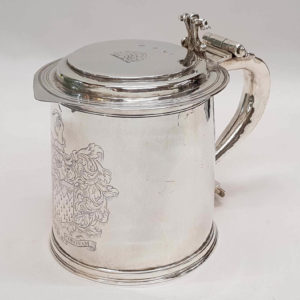
1680
John Ruslen
10242 Charles II Antique Silver Tankard
£7,750
A good early English silver lidded tankard with the flat top design of the period and a scroll handle with decorative thumb piece. Large size. To the front is a crisp hand engraved armorial capped by the crest of a lion holding a serpent and with a motto below – for the Leche family. There is an owl crest engraved to the lid. An excellent example of early hand beaten silver with lots of character. Contains 1450 ml. Weight 852 grams, 27.3 troy ounces. Height 18 cm. Spread 21.3 cm. London 1680. Maker “IR” (see Jacksons page 130), probably John Ruslen (see David Mitchell’s “Silversmiths in Elizabethan and Stuart London”.
-

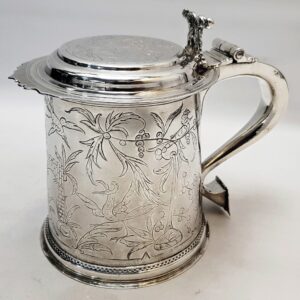
1683
St John Hoyte
10287 Charles II Antique Silver Tankard
Sold
A rare example of early English chinoiserie silver. A finely engraved tankard with the flat hinged lid and s scroll handle typical of the period. Large size and good heavy weight. The body and lid are beautifully hand chased with a fantastical Chinese landscape containing long tailed birds and spidery plants. To the front there is an extraordinary bridge with a coiled snake or rope below. Contains 1500 ml. Weight 982 grams, 31.5 troy ounces. Height 18.6cm (to top of thumb piece). Spread 21cm. Diameter 12.3cm (top). London 1683. Maker St John Hoyte. Sterling silver. 17th century.
-

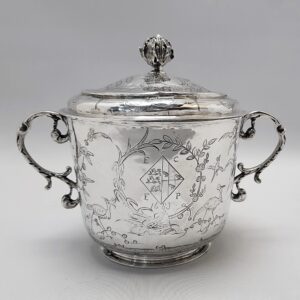
1683
Robert Cooper
10383 Charles II Antique Silver Porringer
£16,500
A rare early English silver cup and cover with finely engraved chinoiserie decoration to the body and lid. Large size and good heavy weight. The fantastical Chinese forest landscape contains exotic long tailed birds and spidery plants depicted in beautiful hand chased ornament. To the front there is a widow’s armorial, owner’s initials, and the date “1683”. The shaped handles are typical of this early period. Weight 575g, 18.4 troy oz. Height 11.2cm (to rim), 17.5cm (to top of finial). Spread 21.8cm. Diameter 14.1cm. London 1683. Maker Robert Cooper. Sterling silver. 17th century.
-

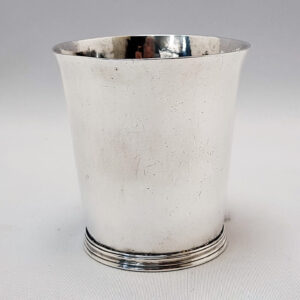
1683
Edward Gladwin
10410 Charles II Antique Silver Beaker
Sold
A handsome early English antique silver beaker of plain, straight sided design having a flared top and simple foot wires. Owner’s initials engraved underneath. Contains 270 ml. Weight 118 grams, 3.7 troy oz. Height 8.7cm. Diameter of top 8.3cm. London 1683. Maker Edward Gladwin – see David Mitchell’s “Silversmiths in Elizabethan and Stuart London”. Sterling silver.
-

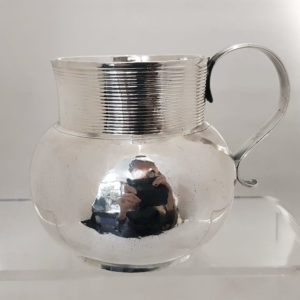
1684
10247 Charles II Antique Silver Mug
£4,750
A rare early English silver mug of plain form. The body is raised from sheet and has a simple strap handle and an incised, reeded neck. This is the earliest type of mug. Contains 520ml. Weight 210 grams, 6.7 troy ounces. Height 16cm. Diameter 7.7cm. Spread across handle 13.2cm. London 1684. Makers mark “PM” start above and below (see Jacksons Page 138). Sterling silver. 17th century.
-

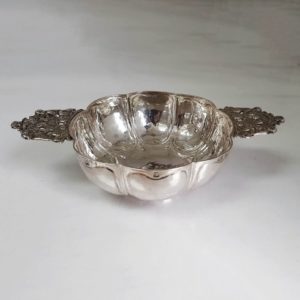
Circa 1685
9779 Antique Dutch Silver Brandy Bowl
£1,650
An antique Dutch silver bowl with lobed decoration and cast pierced handles showing three children climbing on a grape vine. Good large size. Weight 213 grams, 6.8 troy ounces. Height 6cm. Spread 24.21cm. Diameter 14.3cm. Dutch silver marks for Haarlem 1740.